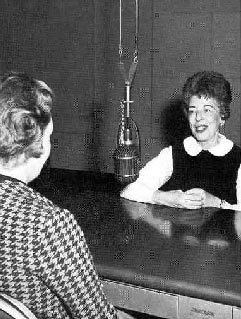Tom Read and WHO News
During the late 1950s and early 1960s
By George F. Davison, Jr. and Tom ReadPage 2
During the 1950s and early 1960s, WHO Radio remained king. It was the flagship of Central Broadcasting Company. It was the entity that had brought prosperity to the company, but radio as a broadcast medium was in transition. Network programs during the day and night were ending. WHO Radio's large staff of musicians and performers was being reduced. The Iowa Barn Dance Frolic ended. New ideas were emerging about how radio stations should handle the broadcast day.
Betty Baker Show and Bill AustinStill, in the late 1950s and early 1960s farm programs and the Betty Baker Show on WHO Radio featured live music performed by Bill Austin on the piano and organ, the Songfellows (a male quartet), and Duane Ellett (Ellett was one of WHO's most versatile performers. He had a marvelous singing voice. He was a quick wit. He was a ventriloquist who entertained legions of Central Iowa young people with his puppet, Floppy, and other characters. He was a man of a thousand voices. And he was co-host of the long-running morning telephone call-in program, "Phone Forum."
In the WHO News Bureau, emphasis was on the morning radio newscasts, Jack Shelley's 12:30 news, as well as expanded newscasts at 6:15 P.M. and at ten o'clock. Most of Iowa still lived in the small towns and rural areas. The vast majority of WHO's listeners were outside of Des Moines. A slogan the station used at the time was "WHO is heard in more homes and automobiles than any other Iowa radio station." Its programs, especially the news and weather, were intended to meet the schedules of a rural audience and to provide them with the information they needed. During the night time hours when WHO's clear channel signal was especially strong in the western plains of Kansas and Colorado, news stories from those areas were included.The WHO News Bureau was well equipped. In the Handbook for News Correspondents, written in 1963, Read described the station's mission, as well as the personnel and equipment devoted to fulfill it:
WHO Radio and WHO Television are licensed to serve hundreds of thousand of persons in Iowa - in the case of WHO Radio, thousands more over a good portion of the United States. Part of this responsibility means providing complete, concise and accurate news reports for which a good deal of the operating budget has been earmarked during the past three decades of broadcasting.Yet, despite one of the most elaborately equipped news bureaus of any station in the country, our news department must rely solely upon its News Correspondents to fill in local areas of news coverage. Just as we have specialists in Des Moines to cover the Statehouse, the courts and political news, so we must have "specialists" to cover the various regional and geographic parts of our signal area where only a first-hand knowledge of the area and its people can be of value in reporting news. These regional "specialists" are our News Correspondents.
The reports from our correspondents are added to the daily file from the Untied Press International Radio and transcontinental "A" and "B" wires, the Associated Press Radio and newspaper "A" wire, Western Union teletype, Sports Ticker Services, a special NBC "Hot Line" (The NBC "Hot Line" was an alert system from New York that let the news department know when there was a national or internationsl story of importance. NBC would present a special report for live use when the "Hot Line" was activated. At some point, WHO Radio used the slogan "Hot Line News" to describe its hourly local newscasts. CBS had a system similar to the NBC "Hot Line". The CBS system was known as "Net Alert".), and private wire teletype. Pound for pound, WHO Editors handle as much copy as any news agency in the middle-west.
Jack Shelly checking the wire
The WHO News Bureau of 1963 was staffed by a number of familiar names:
Jack Shelley, News Bureau Manager
Tom Read, Morning Desk, general assignment
Robert Wilbanks, Night Desk, general assignment
Vern Modeland, State Desk, general film assignment, aviation news
Gus Horn, Dayside Police reporter, Statehouse film assignment
Wayne Greene, Nightside Police reporter, TV newsfilm editor
Ev Hickman, Court House and sheriff reporter, Sunday Desk
Otto Weber, Statehouse and Political Reporter
John Pierron, City Hall reporter and Night Desk
Lisle Shires, Nightside Assignment, special events filmer, film lab
Robert Kress, Film Chief
Clay Rusk, Financial News Editor and weather reporter
Clay Rusk
The WHO Farm Department of 1963 employed Herb Plambeck, Farm Service Director; Keith Kirkpatrick, Lee Kline, Chet Randolph, and Vi Curtis. In the WHO Sports Department were Jim Zabel and Bill Clark.
Next PageWHO main page
WHO-TV main page
Des Moines Radio Stations page
DesMoinesBroadcasting.com home page